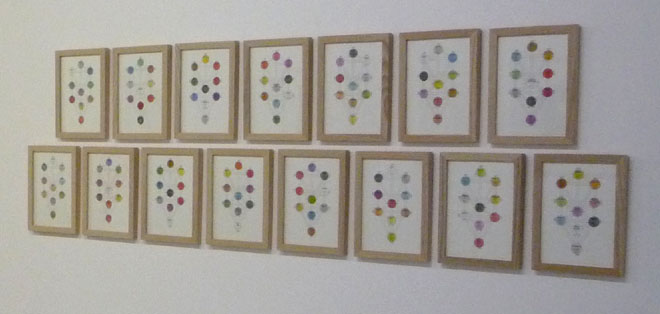Suzanne
Treister
2008
A
Timeline of Science Fiction Inventions: Weapons, Warfare and Security
Wall Drawing: Felt pen and watercolour, 211cm x 552cm
Original
works: Ink and watercolour on paper, 21 x 29.7 cm (15 works)
 Wall drawing (click on each section above to enlarge) |
In A Timeline
of Science Fiction Inventions: Weapons, Warfare and Security Treister
has drawn up a history documenting innovations of imaginary and fantastic
military technology. These include the 'Raytron Apparatus', a form of
aerial surveillance, which was described in 'Beyond the Stars' by Ray
Cummings in 1928, or the 'Control Helmet', from 'Easy Money' by Edward
Hamilton in 1934. The timeline starts in 1726 with the 'Knowledge Engine'
in Gulliver's travels and carries on up to the present day. It allows
us to see the meetings of worlds as these weapons sometimes travel from
the fantastic to manifest themselves into the real, like the 'Atomic
Bomb' described in 'The Crack of Doom' by Robert Cromie in 1895. The
format in which she organises this information is the schema of the
connected circles of the tree of life or the Sephirot, from the Jewish
mystical traditions of the Kabbalah, a representation of linkages between
the worlds above and the physical world below and which map stages of
transformation between these realms.
The formal beauty of these geometries of information reminds us of the hermetic histories of Twentieth Century Abstraction, how it shared the intention to seek the hidden truths that lay beyond or behind everyday appearances. This desire linked mystics such as Hilma Af Klint (who in turn drew on references and symbols that the Alchemists themselves would have recognised) to artists like Kandinsky, Mondrian, Theo van Doesburg, Robert Delaunay and Brancusi and their transformative Theosophical dreams. The belief that art could change the objective conditions of human life requires similar transformations to those that captivated the alchemists: What is real is not the external form, but the essence of things,' wrote Brancusi. 'It is impossible for anyone to express anything essentially real by imitating its exterior surface.' Perhaps, disturbingly, Treister is showing us the world that has emerged in spite of - or perhaps because of - these dizzying intentions.
Excerpt from catalogue essay by Richard Grayson, published by Annely Juda Fine Art, London September 2008

Works
on paper installed in the exhibition, Planet of Signs at, Le
Plateau Art Center, FRAC, Paris, 2009

Wall
drawing at: Annely
Juda Fine Art, London 2008
Links:
Sephirot
TheTemplar
Fellowship of America
Gershom
Scholem
Related works:
http://ensemble.va.com.au/Treister/ALCHEMY/ALCHEMYwashsqfeb.html
http://ensemble.va.com.au/Treister/ALCHEMY/ALCHEMYIndependent28June07.html